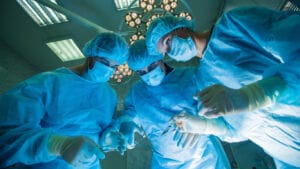Respiratory distress is a common concern for newborns, particularly those born prematurely or with underdeveloped lungs. One of the most effective, non-invasive treatments for infants with respiratory issues is Bubble CPAP (Continuous Positive Airway Pressure). In this article, we’ll explore how Bubble CPAP reduces respiratory distress in infants, focusing on how it works and its specific benefits for improving newborn health. We’ll also examine the differences between Bubble CPAP and traditional infant CPAP systems, highlighting the unique advantages of Bubble CPAP.
What is Bubble CPAP?
Bubble CPAP is a specialized form of respiratory support designed to assist infants in maintaining open airways while they breathe. It functions similarly to standard infant CPAP systems but incorporates bubbles to create gentle oscillations in airway pressure. These oscillations help improve lung function in infants with respiratory distress, allowing them to breathe more comfortably. The system typically includes a nasal interface (such as nasal prongs) that delivers air and oxygen into the infant’s lungs, ensuring the baby’s airways remain open throughout the breathing cycle.
The “bubbles” in the Bubble CPAP system are created in a water chamber connected to the infant’s airway. As air is exhaled, it passes through the water, generating bubbles that produce oscillations in pressure. This technique provides a constant, gentle flow of air, which helps the baby’s lungs stay open and prevents the collapse of the alveoli (tiny air sacs in the lungs).
How Does Bubble CPAP Work?
The primary goal of Bubble CPAP is to keep the airways open, ensuring that oxygen can reach the lungs and be exchanged with carbon dioxide. This is particularly important for premature infants or those with respiratory distress syndrome (RDS), whose lungs are immature and unable to remain inflated on their own.
Bubble CPAP provides positive airway pressure that helps prevent the collapse of the alveoli. The oscillations created by the bubbles in the system further promote lung expansion and improve air distribution throughout the lungs. This continuous airflow ensures that the infant can breathe more effectively with less effort. Additionally, the gentle vibrations the bubbles create aid in mobilizing secretions, which helps clear mucus from the lungs and prevents potential infections.
Critical Benefits of Bubble CPAP in Reducing Respiratory Distress
- Non-Invasive Respiratory Support
One of the critical benefits of Bubble CPAP is that it offers non-invasive respiratory support, reducing the need for more invasive methods like intubation and mechanical ventilation. Mechanical ventilation, while life-saving, can lead to complications such as lung injury or ventilator-associated pneumonia. Bubble CPAP, on the other hand, delivers adequate respiratory support without requiring tubes inserted into the windpipe, reducing the risk of injury and infection.
- Maintains Positive Airway Pressure
Bubble CPAP helps infants maintain a constant level of positive airway pressure, crucial for keeping their airways open. This feature is critical for promoting adequate gas exchange and preventing respiratory failure in infants with underdeveloped lungs.
- Reduces Work of Breathing
One of the main challenges for infants with respiratory distress is the increased effort required to breathe. Breathing becomes laborious for babies who cannot keep their lungs open. With Bubble CPAP, the system supports the infant’s natural breathing efforts, allowing them to breathe with less effort. This is particularly important for premature infants whose muscles and lungs are not fully developed. By reducing the work of breathing, Bubble CPAP helps conserve energy, allowing the infant to focus on growth and development.
- Enhances Lung Development
The gentle oscillations produced by the Bubble CPAP system keep the airways open and stimulate lung development. The small fluctuations in pressure encourage the lungs to expand fully, promoting better overall lung function. This is especially beneficial for preterm infants at risk of long-term respiratory problems. The use of Bubble CPAP in the early stages of life can lead to better respiratory outcomes and a reduced risk of chronic lung disease.
- Minimizes Respiratory Distress Syndrome (RDS) Complications
Respiratory Distress Syndrome (RDS) affects many premature infants. It occurs when the baby’s lungs are not developed enough to produce surfactant, which helps keep the alveoli open. Without sufficient surfactant, the alveoli collapse, making it difficult for the infant to breathe. Bubble CPAP helps prevent these alveoli from collapsing by maintaining positive airway pressure, which reduces the severity of RDS and its complications.
- Prevents Lung Damage
Unlike traditional ventilation methods, which can cause barotrauma (lung injury due to excessive air pressure), Bubble CPAP uses low-level positive pressure to inflate the lungs gently. This reduces the risk of lung damage, which is particularly important for fragile newborns. The system’s ability to deliver respiratory support without causing lung trauma makes it an ideal option for infants at risk of long-term respiratory issues.
Differences Between Bubble CPAP and Traditional Infant CPAP
While both Bubble CPAP and traditional infant CPAP systems provide positive airway pressure to support breathing, there are some critical differences between the two:
- Pressure Oscillations: The most notable difference is that Bubble CPAP introduces gentle pressure oscillations through the creation of bubbles. At the same time, traditional infant CPAP delivers a steady, continuous flow of air without oscillations. These oscillations in Bubble CPAP help improve lung aeration and prevent alveolar collapse more effectively.
- Airway Clearance: Bubble CPAP’s bubbling mechanism helps mobilize mucus and secretions in the lungs, making it easier for infants to clear their airways. Traditional infant CPAP systems do not offer this added benefit.
- Reduced Risk of Overdistension: Bubble CPAP’s gentle oscillations prevent overinflation of the lungs, which can sometimes occur with traditional CPAP systems. This feature helps reduce the risk of lung injury and enhances long-term respiratory outcomes.
Conclusion
Its ability to provide non-invasive, continuous positive airway pressure, along with the gentle oscillations created by the bubbles, makes it an effective and safe option for reducing respiratory distress. By minimizing the work of breathing, preventing alveolar collapse, and promoting lung development, Bubble CPAP plays a crucial role in improving outcomes for infants with respiratory challenges.
To learn about cutting-edge respiratory products, explore B&B Medical Technologies.




